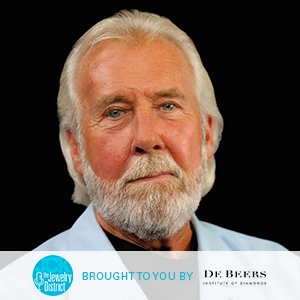
JCK editor-in-chief Victoria Gomelsky and news director Rob Bates sit down with Tom Chatham, chairman of the board of Chatham Created Gems, to discuss his new book about his father’s pioneering work in lab-grown emeralds and his own role in building their family’s company. Tom describes growing up with a “mad scientist” dad and recalls the grueling legal battle the Chathams faced over what to call their product. Finally, he suggests a way that natural and lab-grown diamond producers can apply a simple principle from the colored stone world to coexist and succeed.
Sponsored by De Beers: institute.debeers.com
Show Notes
03:35 From chemistry experiments to emeralds
09:35 Family affair
16:42 What’s in a name?
21:27: Lessons for lab-grown diamond makers
Episode Credits
Hosts: Rob Bates and Victoria Gomelsky
Producer and engineer: Natalie Chomet
Editor: Riley McCaskill
Plugs: @jckmagazine; institute.debeers.com
Show Recap
From chemistry experiments to emeralds
Victoria introduces guest Tom Chatham, chairman of Chatham Created Gems, whom she calls “one of the true pioneers in the industry.” Tom’s father, Carroll Chatham, was among the earliest gem creators, a lifelong chemist who produced the world’s first lab-grown emeralds in his family’s garage in San Francisco in the 1930s, laying the foundation for the lab-grown industry. Tom’s new book, The Chatham Legacy: An American Story, details Carroll’s groundbreaking work and the evolution of the company built by father and son.
“My father loved chemistry from an extremely young age,” Tom explains. “He soaked it up like a sponge.” As a teen, Carroll set his sights on continuing 19th-century French chemist Henri Moissan’s unfulfilled quest to grow diamonds. He built a laboratory in his parents’ basement, but after one of his experiments almost blew up the house, shattering windows across the street, Carroll changed course and focused on growing emeralds—an equally challenging but less dangerous endeavor because the crystals required less intense pressure.
Family affair
Having “a mad scientist” for a father hardly created a typical 1950s family life, Tom says. His dad worked long hours in his laboratory, “so I didn’t see him that often, unless I was in trouble.” Carroll cared little about subjects like English, gym, and history, but he demanded his children excel at math and science—which Tom decided wasn’t his strong suit. At age 20 he approached his dad about a job, and though Carroll had always worked alone, he brought his son aboard Chatham Research Laboratories in 1965. “It was a rebirth of our relationship as father and son because before then we really didn’t have one,” says Tom. Tom’s talent for marketing and business expanded the company and turned its focus to selling cut rather than rough stones.
Rob points out that Chatham is one of the few wholesale companies in the trade, with a name that’s synonymous with a brand. How did that develop? “Because my father was the first to do this, his name was repeated thousands of times in print,” Tom says. Carroll was even featured on Ripley’s Believe It or Not! and What’s My Line? “A lot of the stories were corny…but it got the name out there and it stuck,” says Tom.
What’s in a name?
One anecdote from Tom’s book that intrigued Rob involves a court case over using the word cultured to describe Chatham emeralds. When the Federal Trade Commission sent Carroll a cease-and-desist letter telling him not to use that word, he refused to acquiesce, and a six-month trial followed.
The judge pressured Carroll to reveal his emerald-making process, threatening him with a year in jail for every day he refused, but eventually they found a more sensible solution: “You’re creating emeralds,” the judge said. “Why not just call them created emeralds rather than cultured ones?” It seemed like a brilliant idea. The Chathams changed the product name and all was well…for a few months. Then another cease-and-desist letter arrived prohibiting the word created, and a second legal fight ensued. “Finally, after three years, we got a letter saying, ‘We’ve decided that ‘Chatham Created Emerald’ satisfies the criteria that we’ve established,’” Tom remembers, but the court battles “cost a fortune and took a lot out of my father.”
Lessons for lab-grown diamond makers
Victoria wonders why the emergence of lab-created diamonds is proving so contentious when the industry accepted lab-grown colored gemstones decades ago. Tom suspects it stems from the fact that the diamond industry is much bigger than the colored stone trade, and this is the first time natural diamonds have had a competitor. Colored stones, by contrast, have had a lot of competitors over the years.
In his keynote speech at the inaugural Lab-Grown Diamond Symposium in Dubai this past summer, Tom’s advice for diamond manufacturers was straightforward: Stop the race to the bottom on pricing. “The general public is really embracing this product,” says Tom. “You’re killing each other for no reason at all.”
His advice for natural and lab-grown diamond producers? Take a cue from the colored gemstone world, where lab-grown and natural stones have long coexisted. Focus on your own product and “ignore each other,” he suggests.
Any views expressed in this podcast do not reflect the opinion of JCK, its management, or its advertisers.
- Subscribe to the JCK News Daily
- Subscribe to the JCK Special Report
- Follow JCK on Instagram: @jckmagazine
- Follow JCK on X: @jckmagazine
- Follow JCK on Facebook: @jckmagazine





